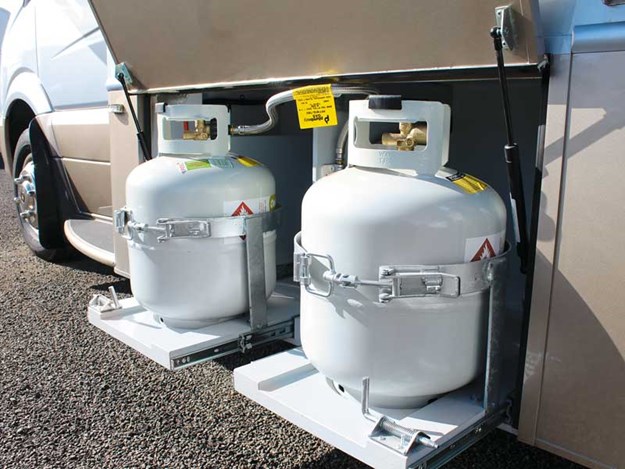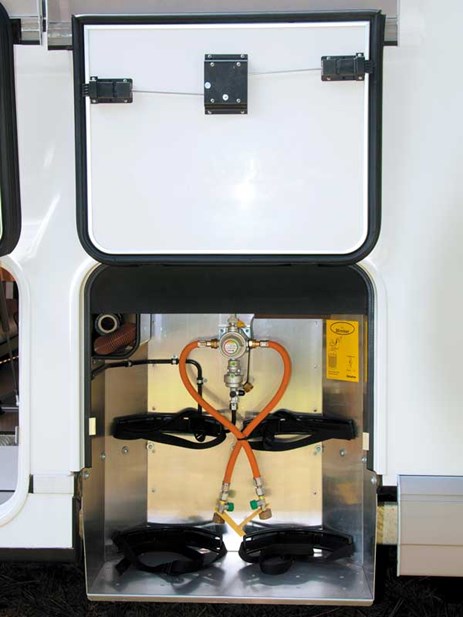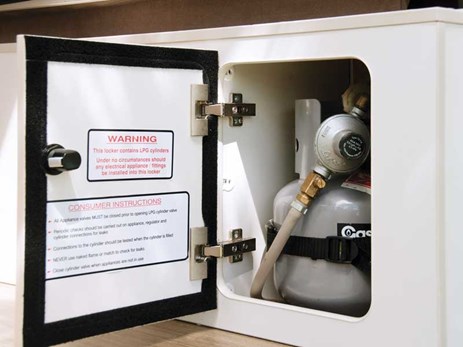LPG can be a dangerous business. For this reason all appliances and installations in RVs must be certified as compliant with the New Zealand regulations.
 |
The slideout base makes the bottles easy to service and change |
Appliances? Installations? What are these? Simply put, appliances need LPG to function and installations (pipework and valves) carry LPG from the bottles to the appliances. Installations in RVs, and all gas fitting work carried out on them, must be carried out by an ‘approved practitioner’, eg. a licenced gas fitter.
The work carried out must comply with the appropriate New Zealand Standard (see sidebar), and once completed the fitter should certify the work is compliant by issuing a Gas Safety Certificate.
To ensure appliances will have the required approvals for use in an RV they should be purchased from a specialist RV accessory shop. Generally speaking, appliance retailers’ products are approved for domestic use but not for use in an RV.
Flued vs un-flued
The combustion chamber in an RV appliance should use air from outside the RV and should discharge the products of combustion outside. These appliances are referred to as ‘flued’ appliances. Those that do not, e.g. a gas califont, are referred to as ‘un-flued’ appliances.
As part of their combustion process they draw oxygen from the RV’s interior and exhaust potentially lethal gases, as well as copious quantities of water vapour, back into the RV’s interior. Un-flued appliances should not be used in an RV.
LPG bottles
 |
Twin hoses, one for each 9kg LPG bottle |
There are two bottle sizes in common use in New Zealand – the 9kg bottle and the smaller 4-4.5kg bottle. Swap-a-bottle (9kg only) outlets are almost everywhere, but the 4-4.5kg bottles have to be refilled while you wait and some outlets can’t/won’t refill the smaller bottles.
Also the number of refill outlets is diminishing so plan ahead if you rely on LPG supply from the small bottles. All bottles are date stamped and must be re-certified every 10 years. It is often cheaper to buy a new bottle than to have your old one re-certified.
Never use a damaged or corroded LPG bottle as it may leak, causing a fire or an explosion. Bottles should be used and stored sitting upright, not on their side as that may cause the bottle to leak. Bottles should be stored in an enclosure built or modified for that purpose.
It should have vents in the walls and floor drain holes so that, should your bottle leak LPG, it will disperse away from the vehicle. Remember, LPG ‘on the loose’ flows to the lowest point and ponds there like water would.
When storing your RV, turn off the LPG bottle valve and all appliances. If storing your RV in a commercial facility check you comply with their rules regards having LPG bottles in stored vehicles.
Keep safe
 |
A 4kg bottle in an approved LPG bottle locker |
Check your installation at least annually. Check for kinks or dents in the copper tubes, and fraying, splitting or cracking of any rubber tubes. When checking for leaks, brush soapy water over the suspect area.
Soap bubbles indicate a leak. Do not use a flame to hunt out LPG leaks. If your gas hobs or any other burners show a yellow flame rather than a blue one, then it is time to have your appliance(s) serviced.
While in your RV, if you smell LPG, your eyes sting or you feel dizzy, turn off the suspected appliance and vacate the RV until it has had a thorough airing.
Have your installation and appliances serviced/checked by an approved practitioner. Don’t use LPG appliances while the RV is on the move. Double check all appliances are turned off while refuelling at a service station.
Better still; make sure the LPG bottle is turned off while the RV is underway. LPG is dangerous. But by following the rules and using common sense the pitfalls can be avoided.
The NZ Standard is ‘AS/NZ5601.2.2013 LPG Gas Installations in Caravans and Boats for non-propulsive purposes incorporating Amendments 1, 2 and 3’. This is available online from shop.standards.govt.nz for the princely sum of $210 + GST).





